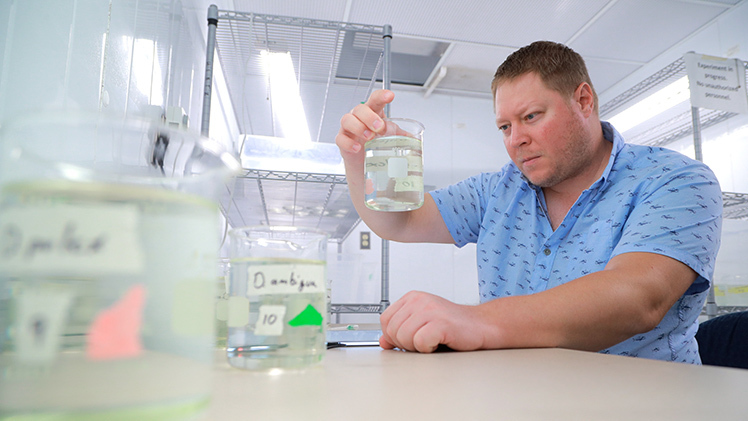As freshwater ecosystems grow saltier around the globe, in part because of overzealous applications of road deicing salts, scientists have had reason to think that inhabitants of these streams, rivers and lakes might adapt to higher salinities over generations.
A new study out of The University of Toledo suggests that’s not necessarily the case for a ubiquitous species of zooplankton that plays a small but mighty role in the food chain.

Dr. William Hintz, an associate professor in the Department of Environmental Sciences, published his research examining the effects of salt pollution across generations of zooplankton in the journal Science of the Total Environment.
In the peer-reviewed journal Science of the Total Environment, Dr. William Hintz, an associate professor in the Department of Environmental Sciences, and Eric Huber, a graduate student who earned a master’s degree in biology from UToledo in 2022, explore the effects of two types of road deicing salts, sodium chloride and calcium chloride, on multiple generations of Daphnia pulex. In finding that exposure decreases these zooplanktons’ lifetime reproduction in all but one combination of factors, regardless of the zooplanktons’ multigenerational exposure histories, they present a case for more stringent and more nuanced policies to protect freshwater ecosystems.
“The U.S. Environmental Protection Agency set chloride exposure thresholds in 1988, but researchers are finding that these guidelines might not adequately protect freshwater ecosystems from the harmful effects of salt pollution,” Hintz said. “Municipalities use several types of chloride-based salts to deice their roads, and our research demonstrates that different types of salts have different effects at different concentrations. If we’re going to develop reactive or proactive policies to protect freshwater ecosystems, it’s important that these policies are specific to salt type.”
Consider calcium chloride, for example.
Although calcium chloride is marketed as an environmentally friendly alternative to the more common sodium chloride, researchers found that it had an equal or greater impact on zooplankton at similar or lower concentrations than sodium chloride.
“Calcium chloride is more effective at a lower concentration as a deicer, so it’s marketed as environmentally friendly because you can use less of it,” Hintz said. “While that may be true, our research suggests that doesn’t mean it’s environmentally friendly. Its effect on zooplankton is just as, if not more, harmful than sodium chloride.”
Hintz is an expert in salt pollution, and this latest journal article builds on a body of research exploring how road deicing salts affect the ecology of freshwater ecosystems and what the implications are for human health and drinking water quality.
This latest article highlights the significance of Daphnia pulex, one of the most common species of zooplankton, or water flea. A key food source for fish, it facilitates a critical energy pathway in freshwater ecosystems despite being too small to see with the naked eye.
“Zooplankton are one of the most important groups of organisms in freshwater ecosystems,” Hintz said. “They’re the link between algae and fish.”
Hintz and other environmental scientists have already documented that increases in salinity lead to decreases in individual populations of zooplankton. In their recent study, the researcher and his collaborators were interested in a generational perspective: Could the species adapt to a new-normal salinity over several generations through what biologists call tradeoffs, perhaps reproducing more frequently over the course of their lives and making up what they lose in brood size?
To test their hypothesis, they set up 180 beakers and monitored zooplankton over their entire lifespan in Hintz’s lab at the UToledo Lake Erie Center. They began with three categories of zooplankton — those that had been exposed over several generations to sodium chloride, those exposed over several generations to calcium chloride and those with no exposure to a road deicer at all — then introduced each type of deicer in high and low concentrations alongside high and low quantities of food.
The researchers found no advantage to multigenerational exposures to either deicer, and all but one combination of experimental factors — low concentrations of sodium chloride — led to lower lifetime reproduction for the zooplankton compared to the control group.
“This suggests that things will not get better for some freshwater organisms in salt-polluted waters over time,” Hintz said. “They will not be resilient to salt pollution in a way that prevents changes in freshwater ecosystems over time.”
Science of the Total Environment published the research in July. Hintz is the senior author and Huber, who is now a biological science technician for the U.S. Fish and Wildlife Service, is the lead author.